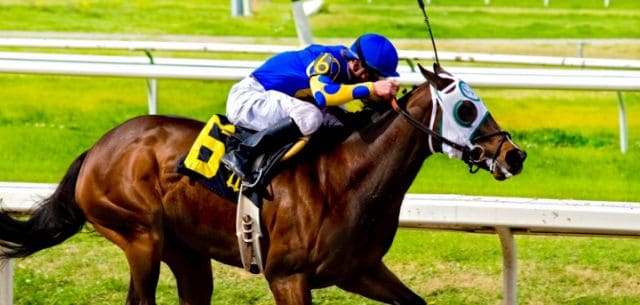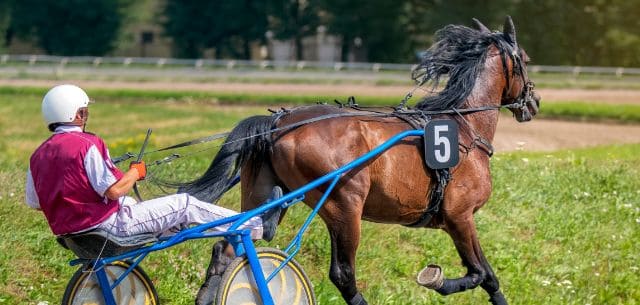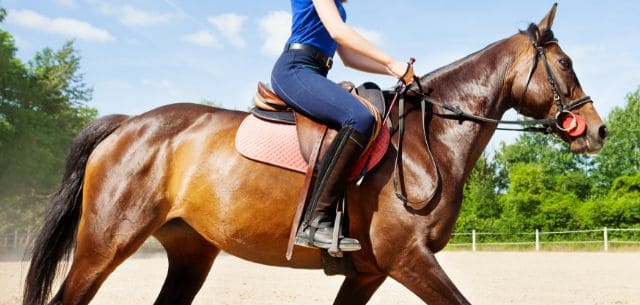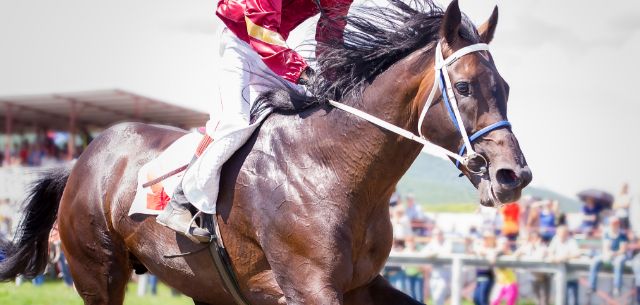Horse Racing Breeds
There are several types of horse breeds, but the thoroughbred, standardbred, Arabian, and quarter-horse are the most known breeds for horse racing because of their distinct characteristics that suit the sport and other equestrian activities. These breeds are also the most influential in developing horse breeding for horse racing.
Before embarking on this new learning, here are some friendly terms that might be helpful to you.
Thoroughbred

Details
- Best known for its use in horse racing.
- Commonly crossbred to form new breeds or to enhance existing ones,
- Influential in creating the Quarter Horse, Standardbred, Anglo-Arabian, and various warmblood breeds.
Origins of Genes
- Three stallions imported into England from the Middle East in the late 17th and early 18th centuries, the Byerley Turk (1680s), the Darley Arabian (1704), and the Godolphin Arabian (1729). They were named after their respective owners Thomas Darley, Lord Godolphin, and Captain Robert Byerly.
- Other stallions of oriental breeding also contributed to the thoroughbred but were less influential. About 160 stallions were traced in the historical record who contributed to the formation of the Thoroughbred.
Characteristics
Best Known
- “hot-blooded” horses, known for their agility, speed, and spirit.
Good Quality
- A well-chiseled head on a long neck
- High withers
- A deep chest
- A short back
- Good depth of hindquarters
- A lean body
- Long legs
Color
- Common: bay, dark bay or brown, chestnut, black, or gray
- Less common: roan and palomino
- Very Rare: White, a recognized color separate from gray
Markings
- Face and lower legs may be marked with white. However, white generally does not appear on the body.
- Not registered by mainstream breed registries are the coat patterns with more than one color on the body, like the Pinto or Appaloosa.
Age
- To enable the standardization of races and other competitions for horses in certain age groups, they generated artificial dates as the basis:
- Born in the Northern Hemisphere: officially a year older on the first of January each year
- Born in the Southern Hemisphere: officially are one year older on the first of August.
Health Complications
- The maximum exertion causes high accident rates and lung bleeding.
- Others are low fertility, abnormally small hearts, and a small hoof-to-body-mass ratio.
Sports
- Mainly for racing,
- Other riding disciplines:
- show jumping
- combined training
- Dressage
- Polo
- fox hunting
Standardbred

Details
- Best known for its capacity in harness racing, either in trot or pace.
- Gait-specific breeding practices ( trotters are bred to trotters, and pacers are bred to pacers) in Standardbreds resulted in having two subpopulations based on gait, which are more distinct than other breeds.
- Because of their speed, standardbreds are utilized to enhance other breeds for harness racing, like the Orlov Trotter and French Trotter.
History
- 17th century – the first trotting races were held in the Americas. It was usually in fields on horses under saddle.
- Mid-18th century – trotting races were held on official courses, with the horses in harness.
- 1879 – the first national Standardbred breed registry was formed in the United States by the National Association of Trotting Horse Breeders.
Origins of Genes
- Narragansett Pacer, Canadian Pacer, Thoroughbred, Norfolk Trotter, Hackney, and Morgan have contributed foundation stock to the Standardbred breed.
- Messenger
- Hambletonian 10.
- known as Rysdyk’s Hambletonian, foaled in 1849.
- Acknowledged as the founding sire of the breed and from whom all Standardbreds descend.
- Sired 1,331 offspring and 40 among the offspring trotted a mile in under 2 minutes and 30 seconds.
- American Star
- foaled in 1822.
- His mare descendants were bred to Hambletonian 10.
Characteristics
Best Known
- More muscled and longer bodied than Thoroughbreds.
- Have more placid dispositions,
- People-oriented and easy-to-train horses.
- Generally a bit heavier in build than Thoroughbreds, but have refined, solid legs and powerful shoulders and hindquarters.
Physical Appearance
- Heads are refined and straight with broad foreheads, large nostrils, and shallow mouths.
- Long body
- Well-defined withers
- Strong shoulders
- Long and heavy muscles
- Muscular neck, slightly arched with a length of medium to long
- Muscular and solid legs
- Very tough and durable hooves
Color
- Mostly bay, brown, or black
- Other colors are chestnut, gray, and roan.
Health Complications
- Osteochondrosis (OC)
- Osteochondrosis dissecans (OCD)
- Other related developmental orthopedic diseases (DOD)
Sports
- Harness racing (trot or pace)
- Equestrian activities include horse shows and pleasure riding, particularly in the Midwestern and Eastern United States and Southern Ontario.
Arabian Horse

Details
- Best known for Endurance Racing
- Recognized for its distinctive head shape and high tail carriage.
- One of the oldest breeds with archaeological evidence of horses in the Middle East, dating back 4,500 years.
- The genetic strength of the desert-bred Arabian horse resulted in the Arabian bloodlines being part of the development of nearly every modern light horse breed. It includes the Thoroughbred, Orlov Trotter, Morgan, American Saddlebred, American Quarter Horse, and Warmblood breeds such as the Trakehner.
- It also influenced the development of the Welsh Pony, the Australian Stock Horse, Percheron draft horse, Appaloosa, and the Colorado Ranger Horse.
- Nowadays, Arabian horses are bred with other breeds to add refinement, endurance, agility, and beauty.
- In the US, Half-Arabians have their registry within the Arabian Horse Association:
- Anglo-Arabians (Arabian-Thoroughbred crosses):
- National Show Horse (an Arabian-Saddlebred cross)
- Quarab (Arabian-Quarter Horse)
- Pintabian
- Welara (Arabian-Welsh Pony)
- Morab (Arabian-Morgan).
- Anglo-Arabians (Arabian-Thoroughbred crosses):
Origins of Genes
- Originated on the Arabian Peninsula, where the resemblance of Arabian horses appeared in rock paintings and inscriptions dating back 3500 years.
- Historically, throughout the Ancient Near East, horses with refined heads and high-carried tails were depicted in artwork, particularly that of Ancient Egypt in the 16th century BC.
- Recent genetic studies of mitochondrial DNA in Arabian horses of Polish and American breeding states that the modern breed has heterogeneous origins with ten haplogroups. However, the modern concept of breed purity in the modern population cannot be traced beyond 200 years
Characteristics
Best Known
- Most have a compact body with a short back.
- Usually have dense, strong bone and good hoof walls.
- Arabian is a strong and hardy light horse breed able to carry any type of rider in most equestrian pursuits.
- Acknowledged for their endurance and superiority in the Endurance riding competition
- Dominant performers in distance competition at international FEI-sponsored endurance events.
Good Quality
- Well-bred Arabians are strong, sound horses with superior stamina.
- Have a deep, well-angled hip and well-laid-back shoulder.
Physical Appearance
- Refined, wedge-shaped heads and a broad forehead
- Large eyes, large nostrils, and small muzzles.
- Most display a distinctive concave or “dished” profile.
- Mostly also have a slight forehead bulge between their eyes, called the jibbah by the Bedouin.
- An arched neck with a large, well-set windpipe set on a refined, clean throatlatch.
Size
- Arabians’ height ranges from 14.1 to 15.1 hands (57 to 61 inches, 145 to 155 cm).
Temperament
- A well-chiseled head on a long neck
- High withers
- A deep chest
- A short back
- Good depth of hindquarters
- A lean body
- Long legs
Color
- Most common: Bay, gray, and chestnut
- Less common: black
- Roan: usually expressing rabicano or sabino patterns with roan features
- All Arabians, no matter their coat color, have black skin, except under white markings. Black skin protects the horse from the intense desert sun.
Marking: White and Gray
- Even though several Arabian horses appear to have a “white” hair coat, they are not genetically “white”.
- The “white” coat is usually created by the natural action of the gray gene. Hence, virtually all white-looking Arabians are actually gray horses.
- A specialized colorization in some older gray Arabians is the “bloody shoulder”, a particular type of “flea-bitten” gray with localized aggregations of pigment on the shoulder.
- Some rare Arabians registered as “white”, having a white coat, pink skin, and dark eyes from birth. They demonstrate a new form of dominant white, the product of a nonsense mutation in DNA tracing to a single stallion foaled in 1996. It is now called the W3.
Sabino
- Sabino coloring is characterized by white markings such as “high white” above the knees and hocks.
- Irregular spotting on the legs, belly, and face
- White markings extend beyond the eyes or under the chin and jaw and are sometimes lacy.
Rabicano
- Rabicano is a partial roan-like pattern
- It does not have combined white and solid hairs over the entire body, except on the midsection and flanks
- the head and legs are solid-colored.
- It is confusing with a young gray horse because of the intermixed hair colors common to both. The difference is that a gray horse consistently lightens with age, while rabicano does not.
Health Complications
Genetic diseases:
- Severe Combined Immunodeficiency (SCID).
- Lavender Foal Syndrome (LFS), also called Coat Color Dilution Lethal (CCDL).
- Cerebellar abiotrophy (CA or CCA).
- Occipital Atlanto-Axial Malformation (OAAM).
- Equine juvenile epilepsy, or Juvenile Idiopathic Epilepsy, sometimes referred to as “benign” epilepsy
- Guttural Pouch Tympany (GPT)
Sports
- Endurance riding and many other fields of equestrian sport.
Other Uses
- Arabians are involved in fairs, movies, parades, circuses, and other places where horses are showcased.
- Mascots for football teams
- Helped on search and rescue teams and occasionally for police work
American Quarter Horse

Details
- Also called Quarter Horse, known for the quarter horse racing.
- Best known as a racehorse, in rodeos, horse shows, and as a working ranch horse.
- American breed excels at sprinting short distances.
- The name is derived from its ability to outrun other horse breeds in races of a quarter mile or less.
- American Quarter Horse Association is the largest breed registry in the world, with almost three million living American Quarter Horses registered in 2014.
History
- The 1600s – On the Eastern seaboard (United States), English Thoroughbred horses were imported and first bred with assorted native horses.
- 1746 – Janus, the grandson of the Godolphin Arabian, was foaled. He contributed genes crucial to developing the colonial “Quarter Horse”.
- 1940 – the American Quarter Horse Association (AQHA) was formed by a group of horsemen and ranchers from the Southwestern United States dedicated to preserving the pedigrees of their ranch horses.
Origins of Genes
- Early foundation sires of Quarter horse and date foaled:
- Steel Dust (1843)
- Shiloh or Old Shiloh (1844)
- Old Cold Deck (1862)
- Lock’s Rondo — one of many “Rondo” horses (1880)
- Old Billy — one of many “Billy” horses (circa 1880)
- Traveler (unknown breeding but known to have been in Texas by 1889
- Peter McCue (1895) registered as a Thoroughbred but of disputed pedigree
- Copperbottom (1828), descendants of Byerley Turk, a foundation sire of the Thoroughbred horse breed
Characteristics
Body Type
- General
- A small, short, refined head
- A straight profile
- a strong, well-muscled body
- A broad chest
- powerful, rounded hindquarters
- Stock Type
- It is shorter, more compact, stocky, and well-muscled, yet agile.
- Well suited for working with livestock, particularly cattle.
- Racing and Hunter Type
- It is taller and smoother muscled than the stock type. Closely resembles the Thoroughbred
Color
- The most common color is sorrel, a brownish red, part of the color group called chestnut by most other breed registries.
- Other colors are bay, black, brown, buckskin, palomino, gray, dun, red dun, grullo (also occasionally referred to as blue dun), red roan, blue roan, bay roan, perlino, cremello, and white.
- Spotted color patterns as long as both parents are registered.
Health Complications
Genetic diseases
- Hyperkalemic periodic paralysis (HYPP)
- Malignant hyperthermia
- Hereditary Equine Regional Dermal Asthenia (HERDA), also known as hyperelastosis cutis (HC)
- Glycogen Branching Enzyme Deficiency (GBED)
- Equine polysaccharide storage myopathy also called EPSM or PSSM
- Lethal White Syndrome
- Cleft Palate Birth defect (It can be caused by genetics, hormones, mineral deficiency, tranquilizers, or steroids)
Sports
- Best known today as a show horse, race horse, reining and cutting horse, rodeo competitor, ranch horse, and all-around family horse.
You can also learn the differences between those mentioned horse racing types, the flat. Jumps or national hunts, harness, endurance, and quarter horse racing. If you are familiar but not knowledgeable enough with turf, dirt, tapeta, Polytrack, etc., you can also learn further details about these track surfaces. Just click the buttons below and know like a pro bettor.
For more information and facts about horse racing, you can also check our glossary and hit the button below.
$150 Deposit Match. Cashback Rewards.
Bet on live horse races like a Pro with AmWager.